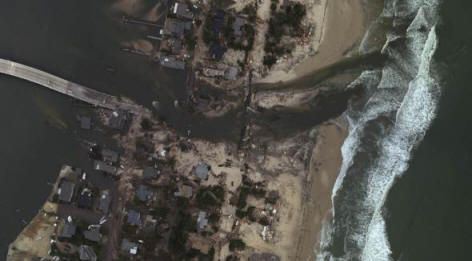Barnegat Bay – Hurricane Sandy – Shellfish <home>
Hurricane Sandy had significant impact on Barnegat Bay. The effects on shellfish, specifically clams, may never be completely know.
 Some of the problems include:
Some of the problems include:
Storm surge within Barnegat
Bay raised water levels 2 meters (6 feet) above normal high-tide levels,
flooding estuarine coastlines and damaging coastal infrastructure.
Barrier-islands that form the estuary's eastern boundary were eroded and
breached.
Much of the seafloor has been rearranged and sediment redistributed.
Sand and other debris have covered areas of the bottom inhabited by
clams.
Water quality has been degraded.
Clams are filter feeders and draw in bay water to feed and breathe. They normally burrow into the bottom sand or mud and open their shells to extend two siphons, one to drew in water and the other to expel waste. Those living in affected areas may have been covered with sand and/or sediment making it impossible to dig up to reach water resulting In suffocation from lack of oxygen.
Water temperature also comes
into play here. Like all other invertebrates, clams are cold-blooded
organism. Their body temperature fluctuates with that of the environment
and their metabolism is directly influenced by water temperature.
Increasing water temperature increases metabolic rate. When the bay
water temperature drops below about 40ͦ F calms will
slow down their metabolism (hibernate)
At the time Sandy hit the
bay, depending on location, the water temperature was above the 40ͦ mark
and most calms were feeding.
If a clam filters water that is polluted or toxic in may not be harmful
to the calm, but the toxins will remain in the body tissue. If one of
these calms is allowed to filter in “clean” water, it will purge the
toxins and be edible within a few weeks to a month.
The problem is that from the results of the hurricane, most of the bay’s water quality was below acceptable levels and the calms were feeding. By December, the water quality started to improve, but the water temperature was below 40ͦ and the hibernating “contaminated” clams probably will not be feeding again until the spring.
Any calms consumed before
they can purge in the spring could potentially be harmful to humans.